If you want to improve muscle definition and fast-track your way to washboard abs, then use this fat loss specific, three-phase, muscle-preserving training system. Everyone is wondering what they need to be doing post-COVID lockdown.
If you want to improve muscle definition and fast-track your way to washboard abs, then use this fat loss specific, three-phase, muscle-preserving training system. Everyone is wondering what they need to be doing post-COVID lockdown.
An awesome article was put together by Tom MacCormick, covering how you can get back to making gains. This inspired me to put this specific piece together for the guys out there who purely want to drop that unwanted COVID-19 fat gain.
Now that more and more gyms are opening again, many guys want to get back into shape – fast.
This simple, effective system of methods increases energy expenditure, session after session, and leaves you in a pool of sweat — you can expect to be finished in less than 45 minutes, provided you perform a proper physical preparation before commencing.
The goal here is to increase energy expenditure over time, and that begins with the efficiency of mobilization and usage of energy via the mitochondria. It shows that when spending time on muscular/strength endurance quality the more positive effects can be seen by increasing the mitochondrial density.1
The higher amount of mitochondria we have in our cells, the faster we can lose fat and improve muscular development. People who engage in this type of training increase the total content of GLUT-4 transporters in the trained muscle. This means that there is an increased maximal capacity for glucose transport in the trained muscle.2
This increase in mitochondria is why Phase 1 is designed to set you up for the successive stages of training.
Throughout each phase, the level of intensity and density will increase in each primary exercise and phase.
The Primary Objective
The goal of any fat loss specific programming is to increase the amount of work (density) completed upon each successive phase of training.
This is a great workout used in most of my new client’s initial starting fat loss phase. From the get-go, my client’s programs are designed to increase energy output via the manipulation of multiple variables in a way that can complement the efficiency of energy production and fat mobilization.
In any fat loss specific program, we need to address three key components:
- Increase the intensity and the quality of the lifting.
- Increase training volume in each training phase.
- Increase the density of the workouts for each successive phase.
Phase 1 – Weeks 1-4
The Lower/Upper Superset Method
Phase 1 – How It Works
By alternating between a lower and upper body movement, we can get more work done, while one muscle is resting, another is working. This constant shift in the muscles:
- Places more significant emphasis on the body
- Increases energy expenditure
- Equates to burning more calories
Exercises like deadlifts, bench presses, squats can be beneficial but are not a necessity. As we know, the initial 2-3 weeks of any new training program will see an improvement from a neuromuscular adaptation standpoint before any substantial muscle growth can occur.3
So it’s essential to select movement patterns that will enable you to progress, grooving them from the first phase so that you can make even more significant progress in the successive stages.
If you are not comfortable squatting, then don’t squat. If you are not comfortable deadlifting, don’t deadlift. It’s simple; you want a result. Don’t do things that may prevent you from achieving that result.
Phase 1 – Directions
Perform each workout (A & B) twice per week. The A and B series of exercises will be following the superset format, while the C series will contain three exercises that act as a finisher. You’ll complete the A series required amount of sets before moving on to the B series and then C series of exercises.
Between each superset, there is also a smaller rest period, which is simply the amount of time it should take you to be prepared to begin the next exercise in the sequence. Stay true to the rest periods and get the job done.
Phase 1 – Training Schedule, Weeks 1-4
- Monday – Workout A
- Tuesday – Workout B
- Wednesday – Active Recovery
- Thursday – Workout A
- Friday – Workout B
- Weekend – Active Recovery/Rest
Phase 1 – Workout A
Complete each series of letters in a superset fashion (one after the other). Once you have completed the second exercise, Start your rest period.
Phase 1 – Workout B
Complete each series of letters in a superset fashion (one after the other). Once you have completed the second exercise, Start your rest period.
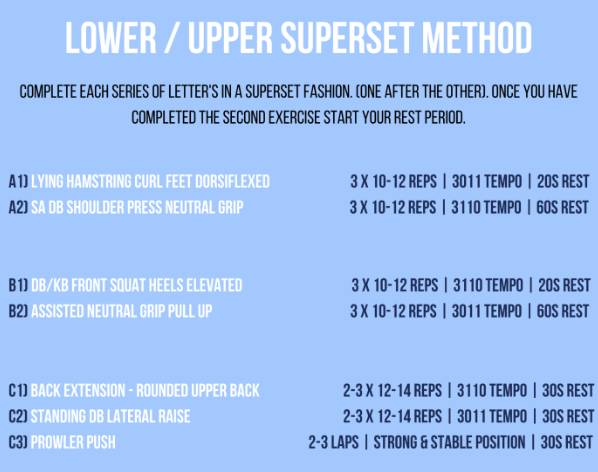
Phase 2 – Weeks 5-8
The Lower/Upper Superset Step Load Method
Phase 2 – How It Works
Following the same suit as Phase 1, Phase 2 alternates between a lower body and upper body movement with one slight adjustment. The adjustment shifts the intensity of weight being lifted during the primary exercises, plus an increase in the amount of work.
The step load method is simple; each set you will decrease the number of reps and increase the amount of weight (intensity) to call upon those high threshold motor units. While it is important to lift heavy, the aim is not to lift as heavy as you can or super close to failure on the first superset of exercises.
As you progress into the sets of eight, make sure to be mindful of how close to failure you are using a 2 RIR approach to those sets. This just means that you use a weight that allows you to complete the reps of 8 but still have two reps left in the tank.
The exercises inside this phase continue with the same style of exercises in the previous phase, with a slight variation in some angles or types of equipment used.
Phase 2 – Directions
Perform each workout (A, B, C) in order. Each week you will double up on one of the sessions and continue to rotate this as you will see below.
The A and B series of exercises will be following the superset format, while the C series will contain three exercises that act as a finisher. You’ll complete the A series before moving on to the B series and then C series of exercises.
Between each superset, there is also a smaller rest period, which is simply the amount of time it should take you to be prepared to begin the next exercise in the sequence. Stay true to the rest periods and get the job done.
The A-series will see the use of the step load method, so make sure you follow along and increase the intensity set after set.
Phase 2 – Training Schedule, Weeks 5-8
Week 5
- Monday – Workout A
- Tuesday – Workout B
- Wednesday – Active Recovery
- Thursday – Workout C
- Friday – Workout A
- Weekend – Active Recovery/Rest
Week 6
- Monday – Workout B
- Tuesday – Workout C
- Wednesday – Active Recovery
- Thursday – Workout A
- Friday – Workout B
- Weekend – Active Recovery/Rest
Week 7
- Monday – Workout C
- Tuesday – Workout A
- Wednesday – Active Recovery
- Thursday – Workout B
- Friday – Workout C
- Weekend – Active Recovery/Rest
Week 8
- Monday – Workout A
- Tuesday – Workout B
- Wednesday – Active Recovery
- Thursday – Workout C
- Friday – Workout A
- Weekend – Active Recovery/Rest
Phase 2 – Workout A
Complete each series of letters in a superset fashion (one after the other). Once you have completed the second exercise, start your rest period. The aim is to improve a high threshold motor unit recruitment, week after week, by increasing the intensity of the weight being used.
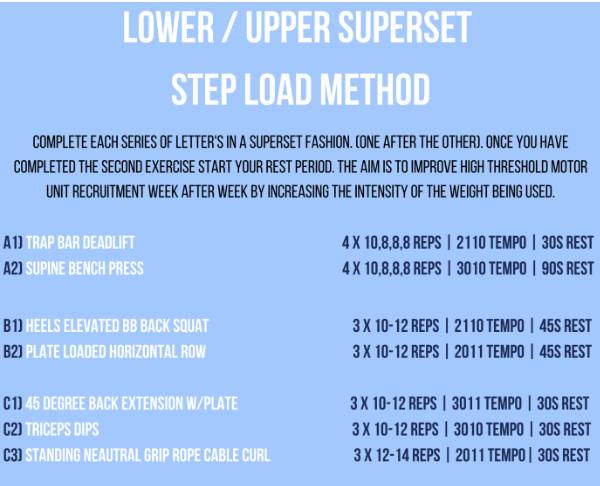
Phase 2 -Workout B
Complete each series of letters in a superset fashion (one after the other). Once you have completed the second exercise, start your rest period. The aim is to improve a high threshold motor unit recruitment week after week by increasing the intensity of the weight being used.
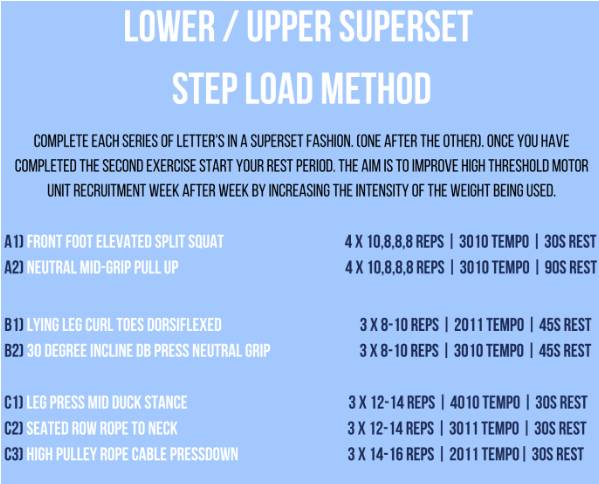
Phase 2 – Workout C
Complete each series of letters in a superset fashion (one after the other). Once you have completed the second exercise, Start your rest period. The aim is to improve a high threshold motor unit recruitment week after week by increasing the intensity of the weight being used.
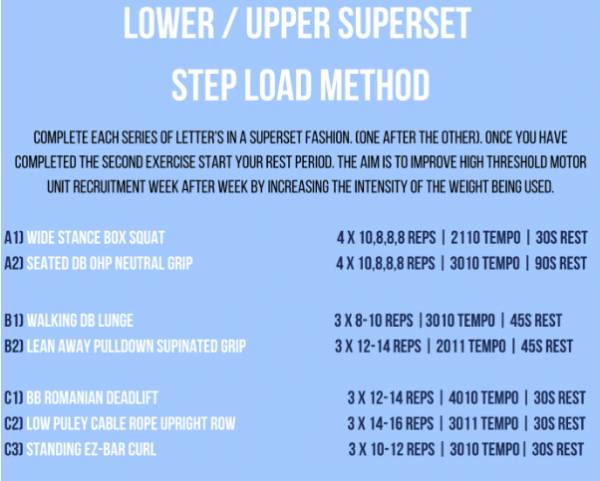
Phase 3 – Weeks 9-12
6-12-25 Body Comp Method
Phase 3 – How It Works
There will be three exercises used per muscle group to be completed as a tri-set broken into the following format:
The goal of this phase is to use it at the peak of our fat loss efforts with an increase in the density of each session, accumulating a ton of lactic acid and cell swelling.
That doesn’t mean you just chase the pump each workout. It is important to match the number of reps with the weight being lifted to maintain a level of intensity, especially with the first exercise of six reps.
Be mindful of the tempo being used within each exercise as this also dictates the training response we are after:
- Maintain the intensity.
- Maintain the tempo.
- Maintain the tension.
- Leave nothing in the tank.
Tip: Try not to reduce the working weight being used within this phase. If you do feel fatigued on some days, just use the rest-pause technique for five seconds and continue to complete the required amount of reps needed to end the set.
The great thing about this phase is you can follow the standard rotation of the workouts, followed by selecting the second session of your choosing.
- Want to work on your chest and back or touch up those delts and arms?
- Aim to complete all three of the workouts and add in the 4th workout of your choosing.
I will outline the three different scenarios in which the focus can be different.
Phase 3 – Training Schedule, Weeks 9-12
Week 9
- Monday – Chest, Back
- Tuesday – Legs
- Wednesday – Active Recovery
- Thursday – Chest, Back
- Friday – Shoulders, Arms
- Weekend – Active Recovery/Rest
Week 10
- Monday– Legs
- Tuesday – Chest, Back
- Wednesday – Active Recovery
- Thursday – Legs
- Friday – Shoulders, Arms
- Weekend – Active Recovery/Rest
Week 11
- Monday – Chest, Back
- Tuesday – Shoulders, Arms
- Wednesday – Active Recovery
- Thursday – Legs
- Friday – Shoulders, Arms
- Weekend – Active Recovery/Rest
Week 12
- Monday – Chest, Back
- Tuesday – Legs
- Wednesday – Active Recovery
- Thursday – Chest, Back
- Friday – Shoulders, Arms
- Weekend – Active Recovery/Rest
Phase 3 – Chest And Back
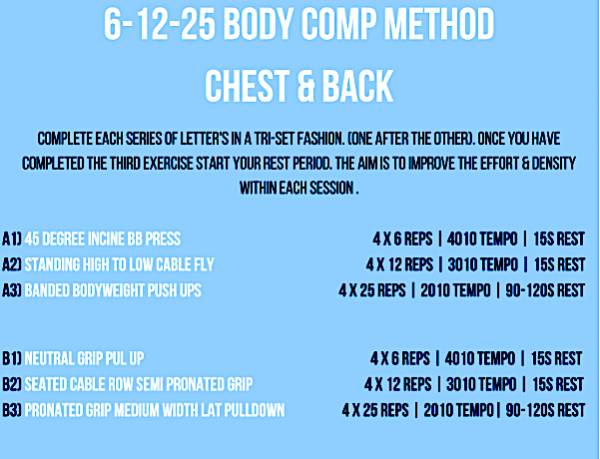
Phase 3 – Legs
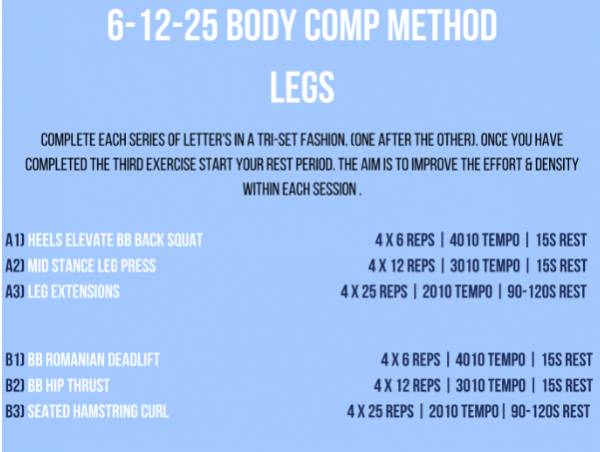
Phase 3 – Shoulders And Arms
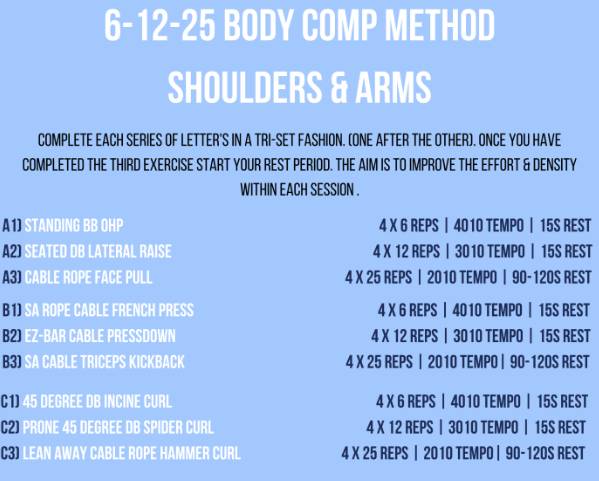
Strategic Nutrition
We all know that regardless of what training method you use, it ultimately comes down to how you have your nutritional intake organized. While this is predominantly all about the training system itself, there is a specific diet periodization that works incredibly well with this approach.
For those who want a little more info regarding how nutrition can impact your physique and performance, I have also given some in-depth background surrounding workout nutrition in this article.
Otherwise, simply follow along with the guidelines below.
Phase 1 – Nutrition Targets, Weeks 1-4
Inside Phase 1, you want to follow a low-mod carbohydrate approach. This initial four week period is to help improve insulin sensitivity, glucose transportation, and mitochondrial density.
While there are a few different ways to classify a low-mod carbohydrate approach, I will keep this simple and base it off a percentage of the total dietary intake.
- Protein – 35%
- Carbs – 20%
- Fats – 45%
For example, an 80 kg male with a TDEE of 2,200 kcal would be set as;
- Protein – 0.35 x 2,200 = 770 kcal divided by 4 = 192 g
- Carbs – 0.2 x 2,200 = 440 kcal divided by 4 = 110 g
- Fats – 0.45 x 2,200 = 990 kcal divided by 9 = 110 g
Phase 2 – Nutrition Targets, Weeks 5-8
Phase 2 will be a decrease in fats and an increase in carbohydrates to improve further insulin sensitivity and glucose transportation via appropriating the increase around our workout. This is to also condition the uptake of glucose and amino into the muscle cells while fuelling performance.
- Protein – 35%
- Carbs – 30%
- Fats – 35%
Following on from 2,200 kcal dietary intake from the 80 kg male let’s assume he has removed 200 kcal for Phase 2:
- Protein – 0.35 x 2,000 = 700 divided by 4 = 175 g
- Carbs – 0.35 x 2,000 = 700 divided by 4 = 175 g
- Fats – 0.30 x 2,000 = 600 divided by 9 = 67 g
Inside the final four weeks, we will follow on with the same trend as phase two, with a reduction in fats but an increase in both protein and carbohydrates from a percentage-based point of view.
Phase 3 – Nutrition Targets, Weeks 9-12
Continuing with the 80 kg male and assuming he was to drop another 200 kcal, his phase three nutrition targets would be:
- Protein – 0.4 x 1,800 = 720 divided by 4 = 180 g
- Carbs – 0.4 x 1,800 = 720 divided by 4 = 180 g
- Fats – 0.2 x 1,800 = 360 divided by 9 = 40 g
This final phase builds up to the peak in regards to the amount of volume and density of the training sessions scheduled. Due to the high amount of volume, the timing of carbohydrates around your workout will be crucial. Insulin sensitivity, glucose transportation, and the partitioning of nutrients have been primed for this so that you can expect some crazy pumps.
References:
1. Tanaka, H., Swensen, T. “Impact of Resistance Training on Endurance Performance.” Sports Med. 25, 191–200 (1998).
2. Tiidus, Peter M & Houston, Michael E., 1941-2008., (author.) & Tupling, A. Russell, 1970-, (author.) “Biochemistry Primer for Exercise Science (Fourth Edition).” Human Kinetics, Champaign, Ill, 2012.
3. Toshio Moritani et al. “Neuromuscular adaptations during the acquisition of muscle strength, power and motor tasks.” Journal of Biomechanics, V. 26, Supplement 1,1993, p. 95-107.






